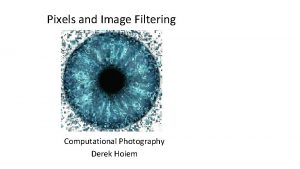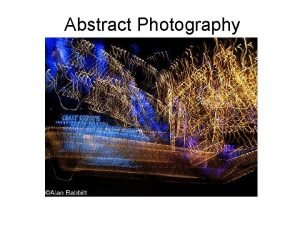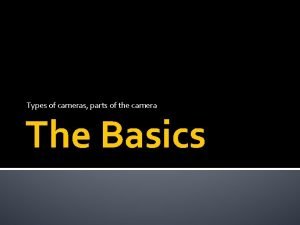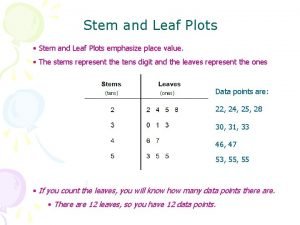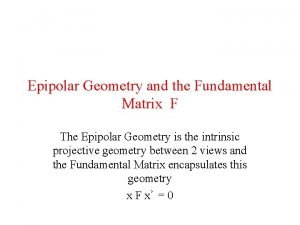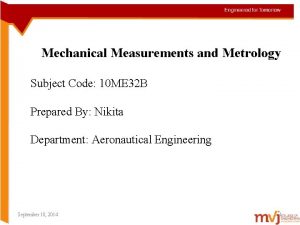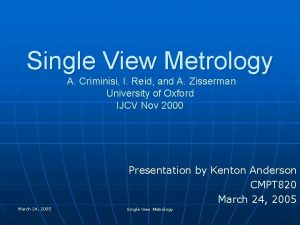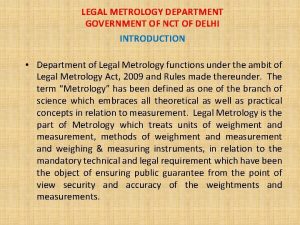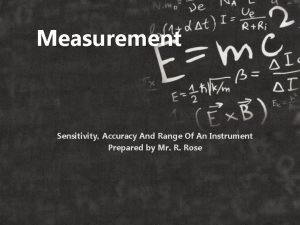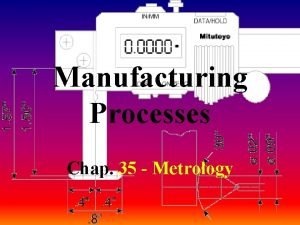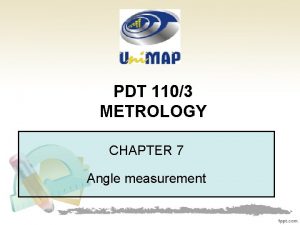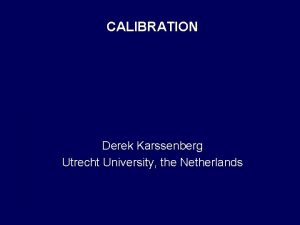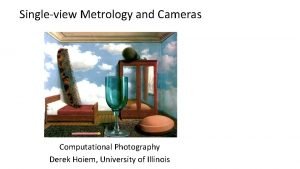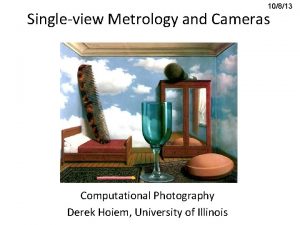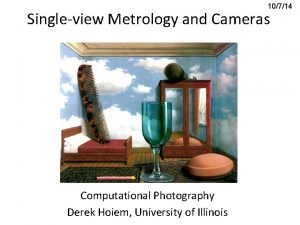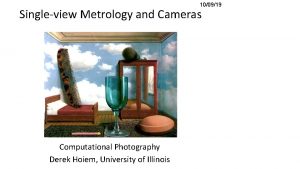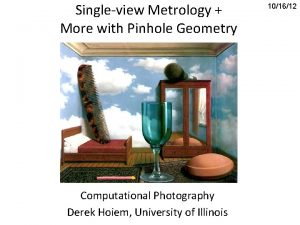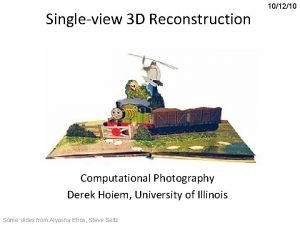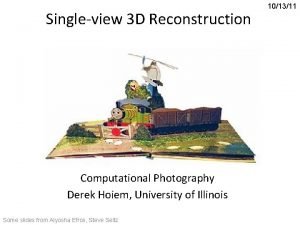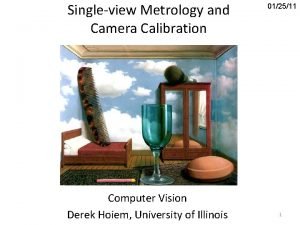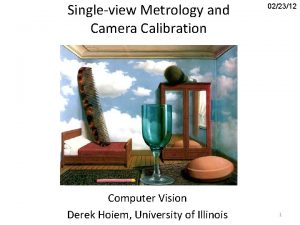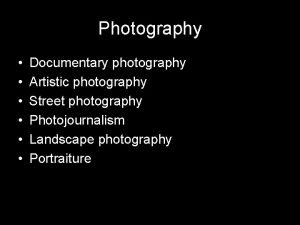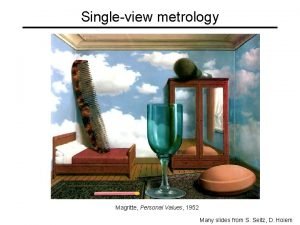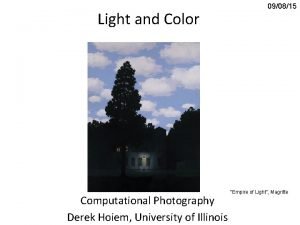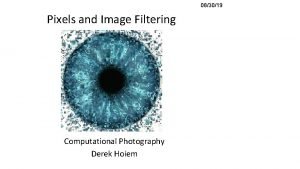100615 Singleview Metrology and Cameras Computational Photography Derek





















































- Slides: 53

10/06/15 Single-view Metrology and Cameras Computational Photography Derek Hoiem, University of Illinois

Project 2 Results • Incomplete list of great project pages Liu, Iou-Jen (hole filling) https: //web. engr. illinois. edu/~iliu 3/cs 445/proj 2/ Hoskere, Vedhus (iterative texture transfer, transfer and blending) https: //web. engr. illinois. edu/~hoskere 2/cs 445/proj 2/ Chen, Chen (iterative texture transfer, blending) https: //web. engr. illinois. edu/~cchen 156/cs 445/proj 2/ Miller, Mark (texture transfer) https: //web. engr. illinois. edu/~mrmillr 3/cs 445/proj 2/ Dong, Yilin https: //web. engr. illinois. edu/~ydong 24/cs 445/proj 2/ Ng, Benjamin https: //web. engr. illinois. edu/~kbng 2/cs 445/proj 2/ Meyer, Michael https: //web. engr. illinois. edu/~mnmeyer 2/cs 445/proj 2/

Synthesis Vedhus Hoskere

Synthesis Iou-Jen Liu

Texture transfer • Transfer based on only luminance preserves original style better SSD with color SSD only luminance Yilin Dong

Texture transfer and blend Vedhus Hoskere

Texture transfer/blend Mark Miller

Hole filling by Criminisi Method Iou-Jen Liu

Review: Pinhole Camera . Optical Center (u 0, v 0) . . u v f . Camera Center (tx, ty, tz) Z Y

Review: Projection Matrix R jw t kw Ow iw

Review: Vanishing Points Vertical vanishing point (at infinity) Vanishing line Vanishing point Slide from Efros, Photo from Criminisi Vanishing point

Perspective and weak perspective Photo credit: Gazette. Live. co. uk

This class • How can we calibrate the camera? • How can we measure the size of objects in the world from an image? • What about other camera properties: focal length, field of view, depth of field, aperture, f -number? • How to do “focus stacking” to get a sharp picture of a nearby object • How the “vertigo effect” works

How to calibrate the camera?

Calibrating the Camera Method 1: Use an object (calibration grid) with known geometry – Correspond image points to 3 d points – Get least squares solution (or non-linear solution)

Calibrating the Camera Method 2: Use vanishing points – Find vanishing points corresponding to orthogonal directions Vanishing line Vanishing point Vertical vanishing point (at infinity) Vanishing point

Take-home question Suppose you have estimated finite three vanishing points corresponding to orthogonal directions: 1) How to solve for intrinsic matrix? (assume K has three parameters) − − The transpose of the rotation matrix is its inverse Use the fact that the 3 D directions are orthogonal 2) How to recover the rotation matrix that is aligned with the 3 D axes defined by these points? − In homogeneous coordinates, 3 d point at infinity is (X, Y, Z, 0) VPy VPx Photo from online Tate collection . VPz

How can we measure the size of 3 D objects from an image? Slide by Steve Seitz

Perspective cues Slide by Steve Seitz

Perspective cues Slide by Steve Seitz

Perspective cues Slide by Steve Seitz

Ames Room

Comparing heights Slide by Steve Seitz Vanishing Point

Slide by Steve Seitz Measuring height 5 4 3 2 1 5. 4 Camera height 3. 3 2. 8

Two views of a scene Image camera center Parallel to ground horizon image plane ground camera looks down slight foreshortening due to camera angle

Which is higher – the camera or the parachute?

Slide by Steve Seitz Measuring height without a giant ruler C Z ground plane Compute Z from image measurements • Need a reference object

The cross ratio Slide by Steve Seitz A Projective Invariant • Something that does not change under projective transformations (including perspective projection) The cross-ratio of 4 collinear points P 3 P 1 P 4 P 2 Can permute the point ordering • 4! = 24 different orders (but only 6 distinct values) This is the fundamental invariant of projective geometry

Slide by Steve Seitz Measuring height scene cross ratio T (top of object) R (reference point) t C v. Z r b H R B image cross ratio (bottom of object) ground plane scene points represented as image points as

Measuring height vz r Slide by Steve Seitz vanishing line (horizon) vx t 0 t v H R H b 0 b image cross ratio vy

Measuring height vanishing line (horizon) vz r t 0 vx vy v m 0 t 1 b 1 Slide by Steve Seitz b 0 b What if the point on the ground plane b 0 is not known? • Here the guy is standing on the box, height of box is known • Use one side of the box to help find b 0 as shown above

Take-home question Assume that the man is 6 ft tall – What is the height of the front of the building? – What is the height of the camera?

Beyond the pinhole: What about focus, aperture, DOF, FOV, etc? . Optical Center (u 0, v 0) . . u v f . Camera Center (tx, ty, tz) Z Y

Adding a lens “circle of confusion” • A lens focuses light onto the film – There is a specific distance at which objects are “in focus” • other points project to a “circle of confusion” in the image – Changing the shape of the lens changes this distance

Focal length, aperture, depth of field F focal point optical center (Center Of Projection) A lens focuses parallel rays onto a single focal point – focal point at a distance f beyond the plane of the lens – Aperture of diameter D restricts the range of rays Slide source: Seitz

The eye • The human eye is a camera – Iris - colored annulus with radial muscles – Pupil - the hole (aperture) whose size is controlled by the iris

Focus with lenses Distance to object Distance to sensor Lens focal length Equation for objects in focus Source: http: //en. wikipedia. org/wiki/File: Lens 3. svg

The aperture and depth of field Slide source: Seitz f / 5. 6 f / 32 Changing the aperture size or focusing distance affects depth of field f-number (f/#) =focal_length / aperture_diameter (e. g. , f/16 means that the focal length is 16 times the diameter) When you change the f-number, you are changing the aperture Flower images from Wikipedia http: //en. wikipedia. org/wiki/Depth_of_field

Varying the aperture Large aperture = small DOF Slide from Efros Small aperture = large DOF

Shrinking the aperture • Why not make the aperture as small as possible? – Less light gets through – Diffraction effects Slide by Steve Seitz

Shrinking the aperture Slide by Steve Seitz

The Photographer’s Great Compromise What we want More spatial resolution How we get it Cost Increase focal length Light, FOV Decrease focal length DOF Decrease aperture Increase aperture Light DOF Shorten exposure Lengthen exposure Light Temporal Res Broader field of view More depth of field More temporal resolution More light

Difficulty in macro (close-up) photography • For close objects, we have a small relative DOF • Can only shrink aperture so far How to get both bugs in focus?

Solution: Focus stacking 1. Take pictures with varying focal length Example from http: //www. wonderfulphotos. com/articles/macro/focus_stacking/

Solution: Focus stacking 1. Take pictures with varying focal length 2. Combine

Focus stacking http: //www. wonderfulphotos. com/articles/macro/focus_stacking/

Focus stacking How to combine? Web answer: With software (Photoshop, Combine. ZM) How to do it automatically?

Focus stacking How to combine? 1. Align images (e. g. , using corresponding points) 2. Two ideas a) Mask regions by hand combine with pyramid blend b) Gradient domain fusion (mixed gradient) without masking Automatic solution would make a very interesting final project Recommended Reading: http: //www. digital-photographyschool. com/an-introduction-to-focusstacking http: //www. zen 20934. zen. co. uk/photograp hy/Workflow. htm#Focus%20 Stacking

Relation between field of view and focal length Field of view (angle width) Film/Sensor Width Focal length

Dolly Zoom or “Vertigo Effect” http: //www. youtube. com/watch? v=NB 4 bikr. Nz. Mk How is this done? Zoom in while moving away http: //en. wikipedia. org/wiki/Focal_length

Dolly zoom (or “Vertigo effect”) Field of view (angle width) Film/Sensor Width Focal length width of object Distance between object and camera

Things to remember • Can calibrate using grid or VP 5 4 3 2 • Can measure relative sizes using VP • Effects of focal length, aperture + tricks 1

Next class • Go over take-home questions from today • Single-view 3 D Reconstruction
 Computational photography uiuc
Computational photography uiuc Computational photography uiuc
Computational photography uiuc Is abstract photography same as conceptual photography
Is abstract photography same as conceptual photography Past tense of camera
Past tense of camera Speed detection of moving vehicle using speed cameras ppt
Speed detection of moving vehicle using speed cameras ppt Part of camera
Part of camera Fun facts about cameras
Fun facts about cameras Image formation in camera
Image formation in camera Epipolar
Epipolar Gamma cameras bbc bitesize
Gamma cameras bbc bitesize Saudi standards, metrology and quality organization
Saudi standards, metrology and quality organization What is software measurement
What is software measurement Working principle of tool makers microscope
Working principle of tool makers microscope Metrology and measurements subject code
Metrology and measurements subject code Emirates authority for standardization and metrology
Emirates authority for standardization and metrology Single view metrology
Single view metrology National metrology institute of japan
National metrology institute of japan Reliability in metrology
Reliability in metrology Metrology department delhi
Metrology department delhi International metrology organization headquarters
International metrology organization headquarters Metrology
Metrology Introduction to metrology
Introduction to metrology Pakistan metrology department
Pakistan metrology department Sensitivity of instrument
Sensitivity of instrument International organization of legal metrology
International organization of legal metrology Veronica scotti
Veronica scotti Metrology
Metrology Metrology
Metrology Ebbing metrology
Ebbing metrology Conclusion on meteorological instruments
Conclusion on meteorological instruments Interchangeability definition in metrology
Interchangeability definition in metrology Define allowance in metrology
Define allowance in metrology Selective assembly in metrology
Selective assembly in metrology Virtual metrology
Virtual metrology Sine table in metrology
Sine table in metrology Introduction of metrology
Introduction of metrology Introduction to metrology
Introduction to metrology Optical metrology techniques
Optical metrology techniques International organisation of legal metrology
International organisation of legal metrology Did you see derek and her or she
Did you see derek and her or she Computational thinking algorithms and programming
Computational thinking algorithms and programming Using mathematics and computational thinking
Using mathematics and computational thinking Cs 514 purdue
Cs 514 purdue Computational engineering and physical modeling
Computational engineering and physical modeling Derek comartin github
Derek comartin github 3825 greenspring avenue
3825 greenspring avenue Derek hoiem
Derek hoiem Derek england
Derek england Derek paiz
Derek paiz Grandfather derek mahon analysis
Grandfather derek mahon analysis Where was jeter born
Where was jeter born Derek walcott fay moston
Derek walcott fay moston Derek comartin
Derek comartin Hill climbing
Hill climbing

